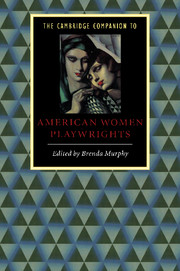11 - Feminist theatre of the seventies in the United States
from Part 3 - New feminists
Published online by Cambridge University Press: 28 May 2006
Summary
American women have been writing plays for at least 150 years, and, if we are willing to look innocently (because he is not a woman) at early American drama, an argument could be made that Royall Tyler’s The Contrast (1787) is the first feminist American play. More commonly, it is Anna Cora Mowatt’s Fashion, written and performed in 1845, that has been considered to be the first popular play written by an American woman (but Fashion is not a feminist play). At least three other scripts compete for the position as “first feminist play ”: Lillian Hellman’s The Children’s Hour (1934), Lorraine Hansberry’s A Raisin in the Sun (1959), and Megan Terry’s Calm Down Mother (1965). There are various angles from which one can contest these selections. Plays written by American women were performed in the nineteenth century; some remain available in collections and paperback printings. They occasioned much delight among their audiences, according to letters and news reports of their time, but hardly lasted beyond the moment or beyond a single tour of American cities. That, of course, is typical of Western drama (indeed, of most drama - not just American drama - or drama written by women). Leading the early one-act plays in the United States were the plays written by women: they authored “little” plays (usually one-acts) performed in towns, villages, and cities in the United States during the late nineteenth and early twentieth centuries.
- Type
- Chapter
- Information
- The Cambridge Companion to American Women Playwrights , pp. 173 - 194Publisher: Cambridge University PressPrint publication year: 1999



